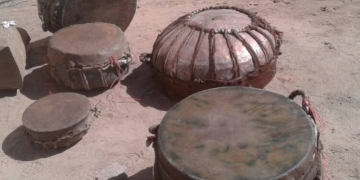Khartoum: Mohammed Fathi
A few years ago, a press mission awarded me the opportunity to be a witness of a traditional (case) that I almost imagined had disappeared, as I trekked to cover an incident of a force (removal) process against the inhabitants of a certain neighborhood of the city of Bahri Known as Dardouq ,carried out by the authorities. the process was met by wide protest by the people who lined up expressing their rejection to the governmental decision . In the midst of these fiery airs, some (drum) thundered, and the voices heightened here and there. All sights were directed towards hordes drawing near from far away.
Dust was hanging over. Whispering was wide around “The drum of the Battahin is booming”. As if bewitched, I came closer to the group which was demonstrating the powerful beating the massive drum.
And as soon as I got there , I found a group of young men with strong muscled arms surrounding drums made of copper and covered with leather exhausted by tense pumpkins on it. People gathered from all directions surrounding these young men .They people around were chanting (Mansour .. Mansureen) as if there were preparations preceding a decisive battle .. The scene impacted me Surprisingly. This (case) of high enthusiasm shoved my mind with questions about the diverted natures of the people of Sudan and their strange and unique heritages, as each tribe has its ancient legacies that organize life in its various aspects, and sets standards of dealing with its conversions , whether peace or war times , prosperity or severity, joy or sadness, and these legacies have been preserved as if it is eternal pledges , resisting the persistent footsteps of the city that overwhelms every obstacles that constrains its path towards modernization . These transitions from the geographical homeland are assumed irresistible , but the decedents of the Bataheen kept the legacy of their ancestors. Time and place did not count in this particular case.
I was eager to find answer about this social ritual. Some people directed me to meet certain Uncle Faris. He was the mayor of the local locality and its most esteemed personality. So I went to him. By that time the drum was beating.
Tears were overflowing, and the hearts throbed with its majestic booming . He told me “The drum that you are watching differs from the drums which belong to other communities . We did not make it with our hands but we obtained it directly from (the sea). It is claded by leather, and it has four types . In the old times it was habitual to place the drums on animals’ backs usually camels not on the ground as you watch now. The leather usually made from the skin of antelopes hunted from what is known now as the Dindir National Park. Now the drums are candied by cattle’s’ skins. In answer to my question about the cases in which the drum percussion is performed, he answered that they are percussed in cases of war and in occasions in peacetimes like the death of one of the distinguished people or in Eids “ Religious Holidays “, indicating that for each of these occasion there is a specific method in percussion which everyone knows its cause whether it is joy or sadness or call for war. He revealed that there are rhythms to arousing enthusiasm or encouragement for war, and there are other rhythms for peaceful occasions .
He indicated by the hand towards one of the drums which he called (the shield ) saying that it is percussed to provoke enthusiasm, as it is sometimes to denote the economic or social situation. Adding that as soon as it is percussed, some of the people especially the aged recall the good old days.
Our narrator , Uncle Faris, surveying around by his sight , as if asking the consult of his predecessors said that there are four types of drums; the (Dingir) and (Abu gaddo), which means according to their dialect (the hot sun), and these two types are percussed at the wars because they have boomings that impact Deep in the soul where they stir enthusiasm .
He said”Drum rhythm is somewhat similar to the army music. It converges with it in arousing enthusiasm and no one can hear it without being affected. He said that he often observes tears flow from the eyes of people when they hear it . Subconsciously, he went on and boasted (my son .. this is a special note). Uncle Faris went on counting types of drums saying “ There is a type called (Nefreen) and when it is beaten , this indicates that there are people who consult about something, and people certainly know its owners, so they will not interrupt them and will leave them alone, just as there is a type called (Oshley) which symbolizes the end of the rivalry between opponents and “closing the page a dispute”. Then I asked Mayor Faris about the significance of these strange names. He replied with a laugh: (My son, these names are known and used in Vasoghli region, the stronghold of the Fung king, and the Bataheen due to their close connections and relationship with that region, they adopted these names).
It seemed that my fascination with the drums would not have passed before it interfered with me again. That time I was on a press mission. I took my footsteps to the homeland of the Ja’aleens’ in Shendi. People gathered again due to the impact of the drums. In such occasions in that land senior and prominent poets lined up, competing in reciting poetry to the gathered celebrators . The excited enthusiastic throngs, admire them, praise them, and interrupts them with expressions of approval for the good of their brains and fine arts, or, according to journalist Hussein Khojali (cut in immatureness’ ) !!
After that, I met poet Sheikh Ibrahim Babiker one of the distinct poets and stallions of the Ja’aleen tribe, who told me a lot about the poets of this region and their gifts in poetry (I may have the opportunity later to write about it extensively), and I asked him about the association of drums with the heritage of the Ja’aleens. He stated that the national drum is associated with joy and distress of the tribes. It deeply impacts people and it is similar to the sword and whip for the Jaa’lyeen tribe. For the tribe is related to Knighthood and courage. He added “ When the drum is percussed , you must come ready to fight”, He explained that the association of the national drum is ancient with the regions of the Jaa’leens, where it earned many names that express the special tribute the tribes holds for the drums; names such as the “Niahas son of Nour”, “Nahas El-Saadab (Abdel-Allhah Wad Saad, and “Nihas Al-Mak Nimir). Every drum of them has its own distinct rhythm that people know “If the drum of Al-Mak nimir beats, this means there is a call for a common gathering, and there is something concerning all the region wide). The poet emphasized that there is a difference in the design of each drum which makes it unique, and consequently each of them is assigned to a person to do the task of the percussion which the people know accurately , meaning that if another person hammered the drum, the people would not certainly interact with him “.!
When II intended to leave the poet stopped me by calling “ O son”. I turned back to him. He surprised me by saying poetry and drums are cousins. I was amazed at the phrase, and he continued (the drums give the poet inspiration, as it links him to specific rituals, and it is all cultural heritage”.















